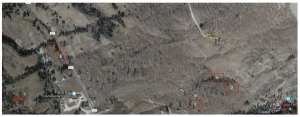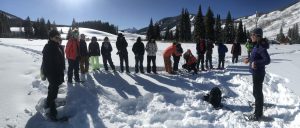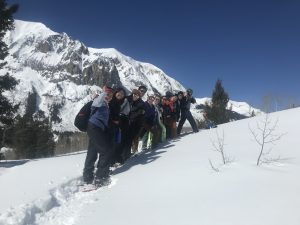Hi Everyone! This past week has been pretty hectic given all the coronavirus news, but I wanted to recap the end of my block. The last few days in Gothic were packed. We finally finished our quinzhee and carved it all out so it could fit 5 to 6 people comfortably. We also hiked to the the top of Judd falls and noticed a pretty start difference between the north and south facing slopes of the ravine. This is actually what inspired my final research project; how to different factors like aspect and elevation effect the types of tree and how much they grow. After taking a group photo on the top of Judd Falls, we hiked back down to the townsite and had some flexibility with our afternoon, one of the many great parts of the block plan.
We read a scientific journal on the effects of climate change and snowpack on bee populations at RMBL. The trends have been for snow to melt earlier in the season, which increases the floral abundance, but not the number of flowering days, with flowering days having a larger effect on bee populations. We also engaged in two hours of zen ecology. Our task was to go out and observe different parts of gothic and see what we could continue to research for our final research project. My partner and I ventured towards billy barr’s house and we noticed a lot of tracks closer to the base of Gothic — potentially a fox hunting a snowshoe hare. We also saw fox scat along the skin tracks, where we encountered billy and he encouraged us finally use the sleds we had been towing around. We built an awesome jump; I felt like a kid again.
We noticed a difference in tree growth depending on the ordinal direction the slope was facing. We ended the day with a book-club like discussion on the journal article, which prepared us to write our own scientific reports. The next morning, we shared our zen ecology observations and solidified our research question and how we were going to collect data. For my specific project, we walked up towards White Rock Mountain, the mountain opposite to Gothic, and took samples from 8 different sites. We recorded snow depth, slope angle, slope aspect, tree type, tree density, elevation, and relevant observations on the area such as how much sun it got, proximity to water, and other topographical features. While writing up our report, we found that slope angle and snow depth were two variables that produced significant and insightful information. We found that aspect and elevation had the largest effect on both tree type and density. North facing slopes were a favorite of conifers due to the shade from the low angled sun and the moisture content. Snowpack is better conserved on these slopes and can last until late spring. Conifers also frequented higher elevations, defining treeline. Meanwhile, aspens favor the sunnier, south facing slopes. We had 3 pairs of sites where elevation was the same, aspect switched from north to south, and tree type changed dramatically from coniferous to deciduous. We were able to display these results on a satellite map, which showed the dramatic distinctions we noticed on the ground.
After collecting data and some extra research, we were curious how factors were impacted by climate change. We learned that snow pack and melt has an impact on soil pH, making an area more or less hospitable to different types of vegetation. The next day, it was time to leave magical gothic. We got an early start and had a really pleasant hike out. Unfortunately for us, during our nighttime sledding adventures, we broke a sled. We got crafty with our new care-taker friend, some recycling, and masking tape and were able to put the sled back together to haul out all of our trash.
Next week back on campus, we wrapped up with a cumulative exam: half on snow science and on half winter ecology. We also submitted our finalized species ID list, detailing common name, scientific name, description, life history, and other revenant and interesting facts about where, when, and what we saw. Additionally, we submitted our written reports with tables and graphs and gave a presentation to the rest of class. While fourth week was pretty crazy given the news and change in end of year plans, it felt good to finish the block together on a strong note.
I am really grateful for all the amazing field trips I have gotten to go while a student at Colorado College, and this trip to Gothic was one of the best. I hope pursue a summer research position in Gothic in the near future. In adventures since the block has ended, I cannot help but shake a tree’s hand and see if its needles are flat and friendly firs, or square and spikes spruces. I find myself fascinated by the diverse amount of birds, ranging from a cheery chickadee to the magnificent magpie to the regal red hawk Thank you so much to the OBE and outdoor education departments and Colorado College. I hope to see you all again soon.


